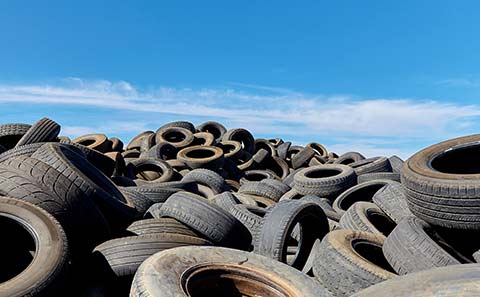Run flat tires are a popular tire technology, but what do they have to offer?
Getting stranded on the side of the road with a flat tire is not ideal. Being forced to change a spare tire or to wait for roadside assistance isn’t either. Run flats remove the hassle of dealing with situations like this.
What is a Run Flat Tire?
Tires manufactured with a run flat technology offer a secure performance even after air pressure loss. They are designed with stronger structures that handle the vehicle’s weight when psi levels run low.
Therefore, during the ride, flat tires will not cause an issue. Instead, the vehicle can safely arrive at a nearby location where the tire can be replaced. The distance and max speed capacity of RFT tires can differ, but most of them offer a 50-mile, 50-mph performance.
Who makes run flat tires? Most top-tier tire brands have their own run flat technologies. The technology has become so widespread that even small manufacturers are dipping their toes into the market.
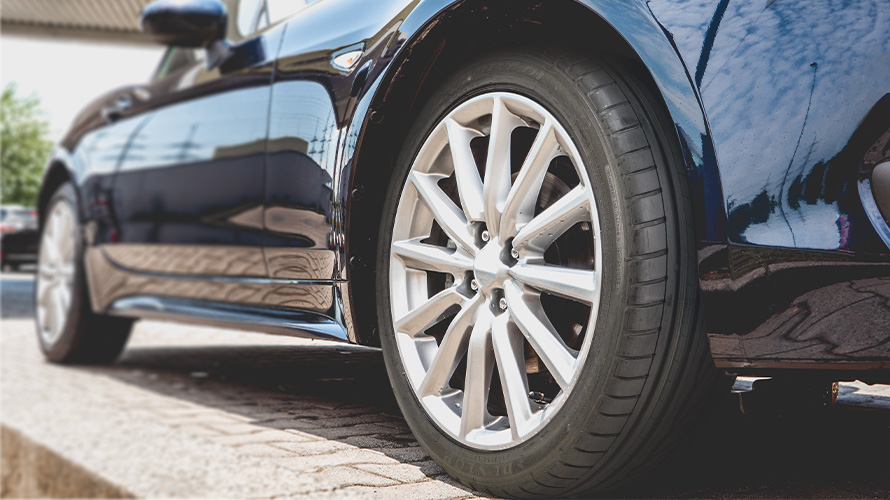
How do Run Flat Tires Work?
Run flat tire technology has evolved in the last couple of decades. This resulted in the development of different types of runflat tire systems. However, the two main types are: self-supporting run flats and supporting ring non-flat tires.
The most widespread runflat tires are ones with self-supporting sidewall structures. This technology strengthens the run flat tire’s sidewall, allowing it to maintain its optimal shape even without air pressure. As a result, the construction provides a limited, temporary performance.
Secondly, the supporting rin runflats feature a hard ring of hard rubber or a similar structure. What happens when a run flat tire goes flat is that this inside allows the rim to run on the rubber ring, supporting the vehicle and its weight.
How Far Can You Drive on Run Flat Tires?
Driving on a deflated tire, even if it is a run flat tire, can only be done for a limited time. The structural integrity fails after a while, making the tire unsafe for use. For this reason, answering the question “How many miles do run flat tires last?” is crucial.
Typically, they tires last for 50 miles, up to the maximum speed of 50 mph. However, it can differ between tire manufacturers. Most tire brands offer this speed and distance, but there are exceptions.
Additionally, it is worth noting that Mercedes-Benz’s original equipment run flats only provide a 25-mile, 25-mph performance. This is half of what most performance, run flat tires offer.
Run Flat Tires Pros and Cons
Like all tires, new runflat tires also have their positive and negative characteristics. Drivers need to assess the needs of their vehicles to determine whether car or SUV run flat tires are necessary for them or not.
So, let’s run through what run flat tires offer for the average driver.
The Benefits of Run Flat Tires
Runflat technology benefits safety, along with everything that comes with it. Driving on run flats can put drivers at ease. Not only do runflat tires cancel the need for spare tires, but they also offer better structural durability.
These are the benefits of runflat tires:
- Run flat tire mileage allows you to safely arrive home or to the nearest tire installer
- Removes the danger of changing flat tires in dangerous conditions
- The reinforced sidewall of self-supporting run flats is able to support the entire weight of the vehicle
- Ideal for sports cars that lack the trunk space needed for spare tires
- Help eliminate spare tires and tire changing tools, lowering the vehicle’s weight and offering a fuel-conscious drive
- Driving with flat tire on the road will not hinder the vehicle’s handling or steering
- Their speed limit when driving on flat tire will not hinder traffic
What are the Cons of Run Flat Tires?
Driving on run flat tires also comes with its downsides. While run on flat tires are often the ideal choice, drivers need to know the drawbacks before purchasing a set.
These are the cons of run flats:
- Run flats cost more compared to standard tires
- Run flat vs regular models cannot be mixed on the same vehicle
- Their heavier construction decreases fuel economy (1-2%) and ride comfort
- Limited availability, they might not be manufactured in the size you need (off-road run flat tires are not available yet)
- Run flats only offer a temporary solution and they should not be repaired after they drive flat
How Much does a Run Flat Tire Cost?
You might be wondering: How much are run flat tires? Are they worth the price?
Yes, run flats cost more sadly. The heavier construction and the cost of different manufacturing technologies drive the price up, usually by one-third of the cost of standard tires.
But, that is not all. The inside of a run flat tire easily gets damaged when riding on a flat tire. If the tire looks flat after air pressure loss, it is highly likely the weight of the vehicle manages to deform it. Unfortunately, such structural damage is not always visible to the naked eye. Because of this, experts do not recommend repairing run flats.
Therefore, when these tires run flat, you will need to replace them. Due to this, run flat tire costs are higher.
Types of Run Flat Tires
With the development of various tire technologies, the number of run flat systems has also increased. While they perform on the same base principle, inside run flat tires the story is different.
Run Flat Technology
The RFT tire meaning varies depending on the type of run flat tire you look at. Run flat tires work in different ways, depending on which tire brand manufactures them.
Since these tires are often made as original equipment models of vehicles, tire and car manufacturers work together to optimize run flat technology. This led to different tire brands developing their own technologies.
Self-Supporting Run Flat (Continental SSR)
Continental’s Self-Supporting technology creates run flat models that feature stiffer sidewalls. This construction utilizes heat-resistant cords and hard rubber to maintain the optimal tire shape even after tire pressure loss.
While some tires with self-supporting technology damage ride quality, tire manufacturers managed to solve this problem. One example is the Continental SSR technology. This run flat technology was developed for low-section tires, which are for most standard rims. Another extra benefit of these tires is that they can be repaired if a qualified tire professional agrees.
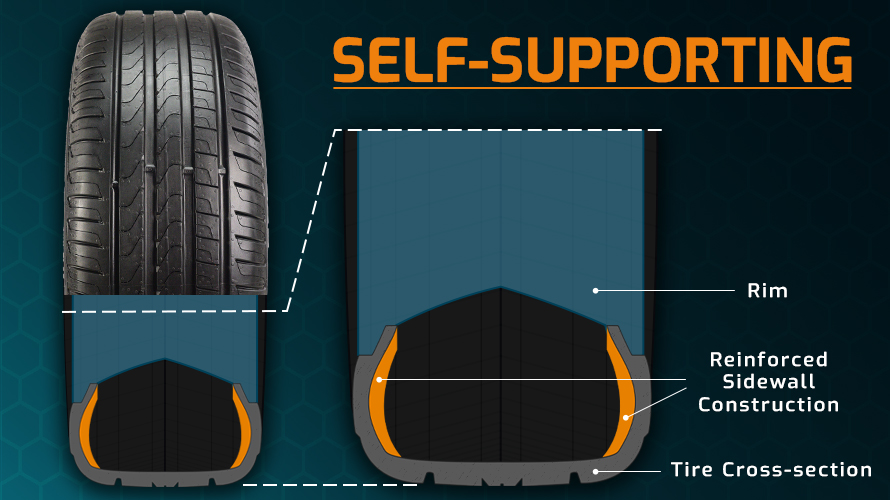
Zero Pressure Tires (Michelin ZP)
A different approach to self-supporting run flats is Michelin’s Zero Pressure technology. The durability and performance of Michelin ZP tires have allowed the tire brand to create original equipment tires for many vehicle models.
The true benefit of Michelin run flats is their durability, allowing the brand to be a top competitor in the run flat market. While their stiff sidewalls result in a rougher ride, the premium rubber materials used to manufacture these tires significantly enhance driving safety levels. Thanks to this, any Michelin run flats last longer than most top-grade conventional tires.
Run Flat with Support Ring (Michelin’s PAX System)
The Supporting Ring run flat technology was also called the auxiliary supported system. It used a ring that was attached to the rim to provide mobility after psi levels dropped. As a result, the responsibility of holding the vehicle fell on the rim which ran on the supporting ring.
Tires manufactured with this technology, including the popular Michlin Pilot Sport PAX PS2, feature durable sidewalls. This contributed to their ride quality, which made them desirable. Sadly, the technology did not have a long lifespan.
As drivers had to invest in the tires and special rims for them (they could not be used on regular rims), their price was high. Drivers had to dig deep in their pockets to finance using such tire-wheel combinations on their vehicles, which made the technology less successful.
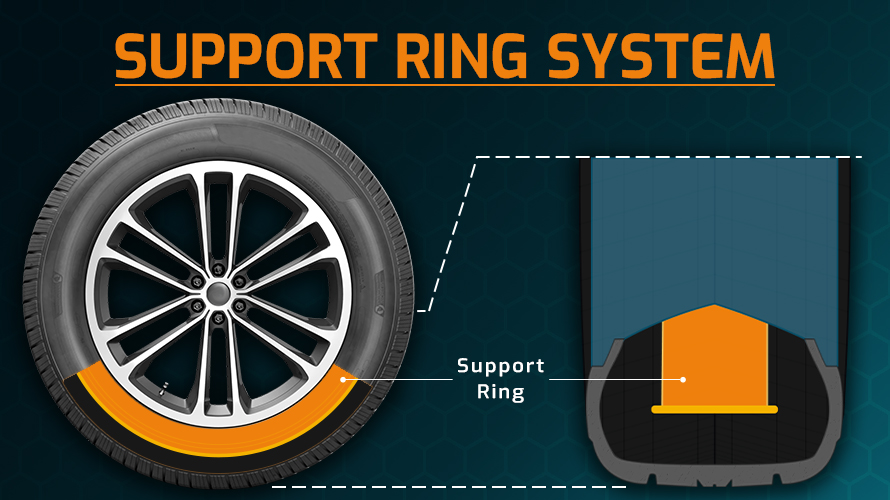
Self-Sealing Tires (Continental ContiSeal)
While technically Self-Sealing tires aren’t run flats, they have deserved a mention. These tires feature a special sealant on the tire’s inner lining that prevents air pressure loss when the structure gets damaged. This sealant was designed to fill the leakage if the puncture is not larger than 5 millimeters and it is located near the tread center.
The beauty of Self-Sealing tires, like those manufactured by Continental, is that they are similar to normal tires. They need tire pressure to perform properly and they can be repaired with modified methods. Such tires avoid the risk of driving cars with flat tires, as the sealant avoids pressure loss in most cases.
Usually, Self-Sealing tires are not offered as original equipment tires. Yet, they can be found on the replacement tire market, usually at the same price as run flats.
Run Flat Tires vs Regular Tires
Switching from run flats to regular tires and vice versa is a big step. You need to know what you gain and lose when doing so before taking this big step.
Drivers who do not want to drive flat tires have run flats are a good alternative. But, due to the heavier construction of these tires, driving comfort and fuel economy will diminish. Still, the glass fiber and polyamide sidewall offer better driving safety compared to standard tires.
On the other hand, regular tires provide the comfort and fuel economy most of us are used to. More flexible sidewalls are able to absorb the driving shock, reducing vibrations, but they will also collapse once psi levels drop. With conventional tires, you will need a spare tire or a tire repair kit at least.
The biggest difference between a run flat tire vs normal tire set is the price. Run flats cost more to manufacture, which increases their price on the market.
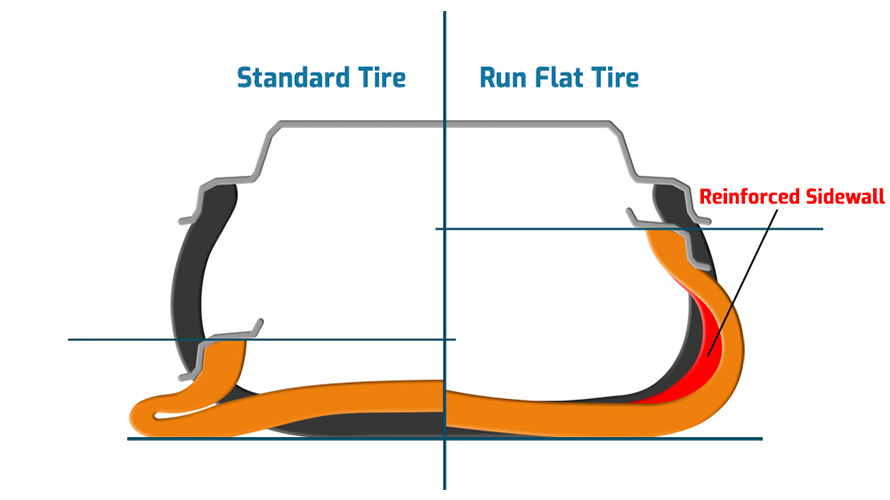
Conclusion: Are Run Flat Tires Worth It?
Are run flat tires good? Do I need run flat tires? The answer is both yes and no to these questions.
Run flats come with benefits and drawbacks and whether you need run flats will depend on your driving needs. There are vehicles and drivers who do not need them, and again there are some who cannot live without them.
The fact that both tire manufacturers and the public trust these tires cannot be challenged. Despite their downsides, run flats are popular.
Whether you purchase run flat truck tires (SUVs) or ones for passenger cars, you will face the same issues. Owners of cars with run flat tires can tell you that not everything is sunshine and rainbows. Yet, whether run flats are the tire set for you or not will greatly depend on your and your vehicle’s needs.
Frequently Asked Questions
Can You Fix a Run Flat Tire?
Run flat tires work until they are run flat. In other words, once they are run without air pressure, they need to be replaced. Based on this, these tires cannot be fixed. Yet, select tire brands managed to create tires that can be repaired, as long as the puncture is in the tread area.
How Long Do Run Flat Tires Last After Purchase?
Tires with the runflat tire technology last as long as regular tires do. Namely, the average lifespan for run flat car tires is about 50,000 to 60,000 miles. External factors such as road conditions, driving habits, car problems, and air pressure levels, can greatly shorten tread life.
Can You Fix a Run Flat Tire with a Nail in It?
Technically speaking, fixing a run flat tire with a nail in it is possible. As long as the damage is not on the sidewall or the shoulder area that causes the flat, run flat tire tread area can be fixed. However, if the sidewall is damaged, it cannot be repaired.
Can You Put Run Flat Tires on Any Car?
Yes, run flat tires can be put on any car, as long as it features a TMPS system and adequate wheels. Unless the rims are manufactured for use with run flats, they can experience heat accumulation and wheel bead separation. For this reason, when using models with a run flat technology, select the correct rims.
